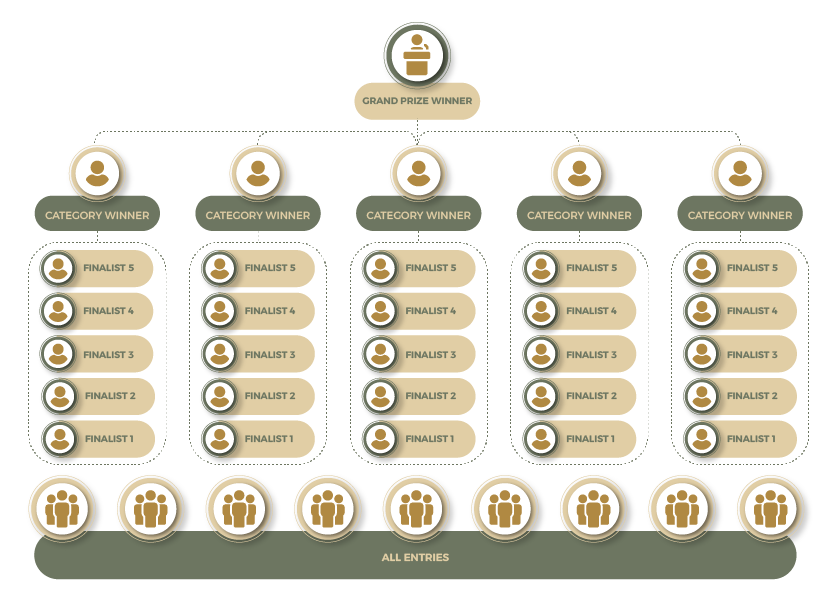Categories in 2025
This year, we’re updating how entries are reviewed—with a new judging panel and a more transparent process. There are 10 categories to enter, including several new ones for 2025.
1
compact Kitchen
(12 Boxes or Less)
Small but mighty. This category rewards kitchens that master efficiency and aesthetics in limited space. The best designs use smart storage, visual tricks, and careful layout planning to make small kitchens feel expansive, purposeful, and beautiful. Space-saving innovation and functional clarity are key scoring factors.
2
Large Kitchen
(13 Boxes or More)
This category celebrates expansive kitchens that demonstrate excellence in layout, workflow, and creativity. The winning entry should balance scale with cohesion, making the space feel functional, intentional, and inviting. Judges will be looking for strong product integration, design continuity, and solutions that leverage space smartly while reflecting personal or lifestyle needs.
3
Zonavita and Decor Fusion
This category recognizes the most seamless and impactful integration of Zonavita’s European-inspired modular systems with Decor’s classic product line. Winning submissions will reflect a high level of product knowledge, creativity in blending brands, and a final result that feels intentionally unified and stylish.
4
Creative Wildcard
Think beyond the kitchen. This category celebrates bold, imaginative uses of Decor or Zonavita products in unconventional applications: retail displays, closets, built-in art pieces, mobile units, studio walls, or entirely new ideas. It’s about thinking freely and showing how versatile the product can be in the hands of a fearless designer.
5
Best Refresh
(Before & After)
This category is for remodels, reconfigurations, or updates that breathe new life into existing kitchens. Entrants must submit high-quality before and after images, supported by a narrative that explains the core design challenges, creative solutions, and resulting improvements. Judges will focus on transformation clarity, smart re-use of space, and visual storytelling.
6
Kitchen for Stan & Connie
Based on a personalized brief provided, this category asks designers to imagine what Stan and Connie’s ideal kitchen would be. The winning entry will not only reflect the couple’s stated needs and lifestyle but also demonstrate empathy, innovation, and personalized problem-solving. It’s about interpreting client desires with technical accuracy and creative care.*
*Download the Creative Brief.
7
Heartwood
(Non-Profit / Community Projects)
This category highlights design work done in service of the greater good — kitchens created for shelters, churches, social enterprises, or other community organizations. Judges will look for impact, dignity, and creativity. The goal is to reward designers who use their craft to elevate lives through thoughtful, accessible, and responsible design.
8
People's Choice
This open-vote category puts the spotlight on what resonates with the public. Shortlisted projects from all categories are eligible. The winner will be the project that captures the hearts and imaginations of our audience — not just for beauty, but for emotional connection, creativity, or relatability.
9
Best Emerging Designer
(<2 Years Selling Decor)
Created to spotlight rising talent in the Decor network, this category is open to designers with less than two years of experience selling Decor products. Entries will be evaluated on creative promise, clear design thinking, and product understanding. The goal is to encourage and elevate those building their voice in the industry.
10
Best Showroom Display
For in-dealer or studio showroom kitchens that serve as sales tools and sources of inspiration. Judges will assess layout logic, product visibility, finish coordination, and how effectively the display communicates Decor’s brand and lifestyle vision. Lighting, staging, and client interaction flow all contribute to scoring.
TBD “People’s Choice” category will include all entries from the three categories mentioned above. Designers are allowed to share their projects with coworkers, family, and friends and encourage them to vote between August 2nd to August 16th.
“Undeniably Different” — this category celebrates exceptional designs in the Small Kitchens, Large Kitchens, and Specialty Rooms categories. Chosen by Decor staff, the winning project will be innovative and original, showcasing unique use of materials and creative thinking.
Please also be aware that the judging panel reserves the right to move projects to an alternative category if deemed appropriate.
Judging Criteria
Each year, the competition is scored using general criteria. For 2025, we’ll be introducing a new judging rubric soon. After the competition, every project will receive feedback to help identify areas for improvement next year.

Creative use of Decor Materials

Cabinet Configuration & Ergonomics

Adherence to Design Principles

Integration of Design Trends

Popularity (People’s Choice)

Complete Design
Statement

Project Photo
Quality
Only one winner per category will be selected with a maximum of one award per Elite Design Awards competition that can be won with the exception for the Grand Prize.
THE JUDGES PANEL
A panel of judges will evaluate and consider eligible entries. The panel is made up of industry experts who will be able to provide unbiased feedback on entries. To ensure fairness and consistency across all entries, final decisions rest with the judging panel and are made with careful consideration of all criteria.
For both Decor and Zonavita, the top five nominations from each entry category will be selected as finalists. 25 finalists per brand. The winner will be revealed at the Elite Design Awards event on October 3, 2024. The winner of the Grand Prize will be selected from among the five category winners in each respective brand during the Elite Design Awards event.

Stan Pauls
CEO, Decor Cabinets Ltd.
Lorem ipsum dolor sit amet, consectetur adipiscing elit. Ut elit tellus, luctus nec ullamcorper mattis, pulvinar dapibus leo.

Ameilya Hall
Designer, Legacy Kitchens
Lorem ipsum dolor sit amet, consectetur adipiscing elit. Ut elit tellus, luctus nec ullamcorper mattis, pulvinar dapibus leo.

Marcos Gaubert
Director Of Marketing, Decor Cabinets Ltd.
Marcos Gaubert has more than 15 years of combined marketing and sales experience in fields such as manufacturing, retail, and software.

Michelle Vogl
Designer, Interiors By J Curry
Lorem ipsum dolor sit amet, consectetur adipiscing elit. Ut elit tellus, luctus nec ullamcorper mattis, pulvinar dapibus leo.

Zach Pauls
Special Project Manager, Decor Cabinets Ltd.
Lorem ipsum dolor sit amet, consectetur adipiscing elit. Ut elit tellus, luctus nec ullamcorper mattis, pulvinar dapibus leo.

Candace Rudd
Showroom Manager, Two30Nine
Lorem ipsum dolor sit amet, consectetur adipiscing elit. Ut elit tellus, luctus nec ullamcorper mattis, pulvinar dapibus leo.
People's Choice
The People’s Choice category is voted on by the community rather than a judges’ panel. This category will contain all entries from the nine categories.
Designers can share their entry with coworkers, family, and friends to vote on their projects.
The voting will be open from August 21st to August 29th.
All People’s Choice category finalists and winners will be announced at the same time as others.
Photo Quality
Ensure your entry photos show your project in the best light! Here are 10 tips for taking photos of your kitchen.
Before you start shooting, make sure the kitchen is clean and well-organized. Remove any unnecessary items or clutter that might distract from the main focus. Choose a few well-chosen items such as an abstract piece of art, a vase, or fresh flowers when staging.
Find the best angle to showcase the kitchen. Shooting horizontally from the kitchen island can provide a dynamic perspective, giving viewers a comprehensive view of the space. This angle often captures countertops, appliances, and design elements in a visually appealing way.
Ensure that your camera is level and avoid tilting it either up or down. Keeping the camera straight maintains the lines in the frame and prevents distortion, contributing to a balanced composition. Distorted lines can be distracting and may not accurately represent the kitchen’s layout.
Experiment with different angles to capture the kitchen’s beauty from various perspectives. Shooting from a corner or slightly off-center can add depth to the image, showcasing the layout and features effectively.
*Remember that horizontal photographs are often preferred for showcasing kitchens. They provide a natural and expansive view, allowing viewers to appreciate the entire kitchen space. Horizontal shots can convey a sense of openness and highlight design elements well.
A stable camera is essential for sharp images. A tripod helps eliminate camera shake, allowing you to use longer exposure times if needed. This is especially important in lower light situations. Here are some recommendations for camera tripods and iPhone tripods.
Whenever possible, use natural light. Plenty of light is essential for a great image. Position yourself so that the light falls onto the kitchen, avoiding harsh shadows. Early morning or late afternoon often provides soft, flattering light.
Ensure accurate color representation by setting the white balance according to the lighting conditions. This can be adjusted manually or set to an appropriate preset on your camera.
Choose a moderate aperture (f/4 to f/8) to ensure a deep depth of field. This will keep both close and distant elements in focus, showcasing the entire kitchen. When using a DSLR this will be set for you in automatic shooting mode, use manual mode to adjust yourself. If you are using an iPhone you can test using different shooting modes like panoramic, cinematic, or portrait mode.
Pay attention to composition. Use leading lines, such as countertops or cabinets, to guide the viewer’s eye through the image. Consider the rule of thirds for a balanced composition.
Capture the small details that make the kitchen unique. Close-up shots of stylish utensils, fresh ingredients, or unique textures can add interest to your photo set.
Use photo editing software such as Lightroom or Photoshop to enhance your images. Adjust brightness, contrast, and color balance if needed. Be careful not to over-edit, aiming for a natural, well-lit look.
Once the photos are edited, you need to export them from your editing software. Some programs have pre-made settings for print or digital use or sliders for high to low resolution. There are guides online with setting recommendations for different platforms and mediums (for where you will use the photos). As a rule, we recommend exporting high resolution JPEG or PNG images.



